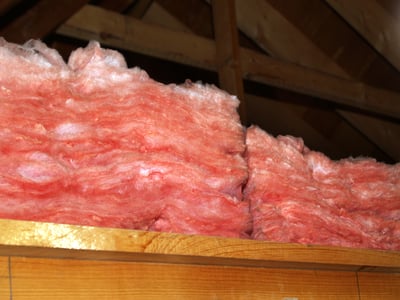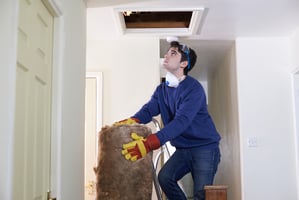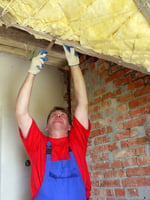The attic crawl space gets the most attention at Christmastime when the decorations come out. The...
What to Know Before You Insulate an Attic Crawl Space
 If you're getting the house ready for the holidays, chances are it's time to get those decorations down from the attic crawl space, a feature that is common to the flat-roofed row homes of Washington, DC. Many homeowners add insulation up there, and there are some good reasons you should, too. Here are some important things you should know before you insulate an attic crawl space.
If you're getting the house ready for the holidays, chances are it's time to get those decorations down from the attic crawl space, a feature that is common to the flat-roofed row homes of Washington, DC. Many homeowners add insulation up there, and there are some good reasons you should, too. Here are some important things you should know before you insulate an attic crawl space.
Should I Insulate My Attic Crawl Space?
If your attic is just a crawl space, you may wonder whether you even need to insulate it. The short answer is an unequivocal yes. With its position at the peak of your house, rising heat won’t slow down until it gets there. If it’s cold outside, you don’t want to lose money because the heat is going to the attic. Even if that open space is small, it is still open, and during a typical DC summer, the heat can build to potentially dangerous levels. Either way, insulating is a smart decision.
What You Need to Know Before You Insulate
Insulation comes in various forms, from sheets to foam to batts or loose fill made of fiberglass, cellulose, or mineral wool. The foam is the most expensive type of insulation, and it should not be used for any substantial-sized space, even your crawl space. Sheets are typically rigid and quite compressed, leaving the most popular choice for an attic to be either batts or loose-fill types of insulation.
It’s essential to know the R-value, which is a measure of insulation's ability to resist heat traveling through it, enabling you to choose the most appropriate option. The higher the value of the insulation, the better the thermal performance. The R-Value is generally easy to find on the insulation's packaging.
Before you start to insulate an attic crawl space, you need to pay attention to recessed lighting fixtures in the ceiling, and here's why: light fixtures are made of materials that conduct heat. Of course, not all types of fixtures are manufactured in the same way, but some can be fire hazards if they touch the insulation. The two primary things you'll want to decide before undertaking this project are what type of insulation you need and the rating on any recessed light fixtures that may come in contact with insulation.
Preventing Fire: Special Consideration for Recessed Lighting
If you have recessed lighting set into the floor-ceiling of the area to be insulated, it’s critical to know whether the lights are IC-rated or non-I IC-rated. (IC stands for Insulation Contact.) If your recessed lighting is IC-rated, then it can be safely used where insulation is present. If the lights are non-IC rated, however, they should be replaced, as the insulation could combust from the presence of high heat.
It's a simple matter to ascertain whether your recessed lights are safe around insulation or not. The canister portion of the lighting will be marked with IC or non-IC. Look for that label, and make sure you keep the insulation at least three inches away from non-IC lighting. Your best bet is not to take any chances at all and instead have a licensed electrician inspect your fixtures and, if necessary, make lighting replacements or retrofits prior to proceeding with insulation.
Thinking Ahead: Consider an Attic Fan for the Summer
One of the best ways to keep the outside temperatures outside is to install attic fans and exhaust fans. Circulating the air and drawing it up and out through the attic vents can keep your house cooler and more comfortable at a much lower cost than air conditioning.
Attic fans can change things for the better when it comes to the comfort of your home. In addition to keeping the heat out, your attic fans will also push back a heavy wave of humidity. If the stifling weather doesn’t stay in the attic, it keeps the whole house cooler. Running the attic fan on hot sunny days can save your air conditioner from running at full capacity, and that's something you'll certainly appreciate when those utility bills show up in your mailbox.
Insulating your attic crawlspace can save you heating costs in a cold climate. It will also help hold in the cool air when the air conditioner is on. It doesn’t have to be a huge project - the important thing is that you insulate safely. The best way to be sure your lighting fixtures are safe is to talk to professionals. Before you start to insulate, contact Wilcox Electric.



